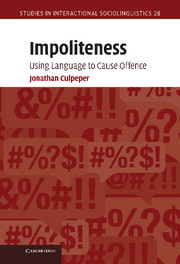Book contents
- Frontmatter
- Contents
- List of figures and tables
- Preface
- Introducing impoliteness
- 1 Understanding impoliteness I: Face and social norms
- 2 Understanding impoliteness II: Intentionality and emotions
- 3 Impoliteness metadiscourse
- 4 Conventionalised formulaic impoliteness and its intensification
- 5 Non-conventionalised impoliteness: Implicational impoliteness
- 6 Impoliteness events: Co-texts and contexts
- 7 Impoliteness events: Functions
- 8 Conclusions
- Notes
- References
- Index
7 - Impoliteness events: Functions
Published online by Cambridge University Press: 16 May 2011
- Frontmatter
- Contents
- List of figures and tables
- Preface
- Introducing impoliteness
- 1 Understanding impoliteness I: Face and social norms
- 2 Understanding impoliteness II: Intentionality and emotions
- 3 Impoliteness metadiscourse
- 4 Conventionalised formulaic impoliteness and its intensification
- 5 Non-conventionalised impoliteness: Implicational impoliteness
- 6 Impoliteness events: Co-texts and contexts
- 7 Impoliteness events: Functions
- 8 Conclusions
- Notes
- References
- Index
Summary
Introduction
My aim in this chapter is to describe the functions of impoliteness, and, more specifically, impoliteness events. As I will be considering rather more extended examples of discourse than hitherto, I will also take the opportunity to cast light on some discoursal patterns associated with impoliteness events. Impoliteness events, as described in Section 6.1, can consist of a single utterance or several utterances building a discourse directed towards certain ends. The kind of impoliteness I focus on is what Beebe (1995: 154) calls ‘instrumental’: the use of impoliteness ‘to serve some instrumental goal’. The notion of instrumental impoliteness echoes the notion of instrumental aggression, long established in the aggression literature (see Buss 1961: 2–4). There have been a few attempts to identify the functions of instrumental impoliteness. Kasper (1990), reviewing linguistic impoliteness, includes a section on rudeness where she proposes that there are three kinds of function for motivated rudeness: (1) rudeness due to lack of affect control, (2) strategic rudeness and (3) ironic rudeness. Beebe (1995), having analysed approximately 600 examples of perceived rudeness, argues that there are two main functions: (1) to get power, and (2) to vent negative feelings. In fact, given that Kasper's discussion of strategic rudeness has much to do with power and that her third category, ironic rudeness, is a subcategory of the second, there is much overlap between these two schemes: both identify the expression of negative feelings and strategic power as key.
- Type
- Chapter
- Information
- ImpolitenessUsing Language to Cause Offence, pp. 220 - 253Publisher: Cambridge University PressPrint publication year: 2011



